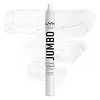What's inside
What's inside
 Key Ingredients
Key Ingredients

 Benefits
Benefits

No benefits
 Concerns
Concerns

 Ingredients Side-by-side
Ingredients Side-by-side

Isododecane
EmollientCyclopentasiloxane
EmollientPEG/PPG-19/19 Dimethicone
EmulsifyingSynthetic Wax
AbrasiveHydrogenated Polydicyclopentadiene
Calcium Sodium Borosilicate
Nylon-12
C20-40 Alcohols
EmulsifyingPerfluorononyl Dimethicone
Skin ConditioningSilica
AbrasiveSynthetic Fluorphlogopite
Calcium Aluminum Borosilicate
Polyglyceryl-4 Diisostearate/Polyhydroxystearate/Sebacate
EmulsifyingPolyethylene Terephthalate
Polyethylene
AbrasivePentaerythrityl Tetra-Di-T-Butyl Hydroxyhydrocinnamate
AntioxidantAcrylates Copolymer
Tin Oxide
AbrasiveTocopherol
AntioxidantPolyurethane-11
Mica
Cosmetic ColorantIron Oxides
CI 77891
Cosmetic ColorantCI 77007
Cosmetic ColorantCI 77510
Cosmetic ColorantCI 77400
Cosmetic ColorantCI 77000
Cosmetic ColorantCI 75470
Cosmetic ColorantIsododecane, Cyclopentasiloxane, PEG/PPG-19/19 Dimethicone, Synthetic Wax, Hydrogenated Polydicyclopentadiene, Calcium Sodium Borosilicate, Nylon-12, C20-40 Alcohols, Perfluorononyl Dimethicone, Silica, Synthetic Fluorphlogopite, Calcium Aluminum Borosilicate, Polyglyceryl-4 Diisostearate/Polyhydroxystearate/Sebacate, Polyethylene Terephthalate, Polyethylene, Pentaerythrityl Tetra-Di-T-Butyl Hydroxyhydrocinnamate, Acrylates Copolymer, Tin Oxide, Tocopherol, Polyurethane-11, Mica, Iron Oxides, CI 77891, CI 77007, CI 77510, CI 77400, CI 77000, CI 75470
Isononyl Isononanoate
EmollientOctyldodecanol
EmollientEthylhexyl Palmitate
EmollientIsostearyl Isostearate
EmollientEuphorbia Cerifera Wax
Ceresin
Emulsion StabilisingMicrocrystalline Wax
Emulsion StabilisingCopernicia Cerifera Wax
Polyethylene
AbrasiveBeeswax
Emulsion StabilisingTocopheryl Acetate
AntioxidantBHA
AntioxidantButylparaben
MaskingIsobutylparaben
AntimicrobialIsopropylparaben
PreservativeMica
Cosmetic ColorantCI 77891
Cosmetic ColorantIron Oxides
CI 75470
Cosmetic ColorantCI 77288
Cosmetic ColorantCI 77007
Cosmetic ColorantCI 77510
Cosmetic ColorantCI 42090
Cosmetic ColorantCI 19140
Cosmetic ColorantIsononyl Isononanoate, Octyldodecanol, Ethylhexyl Palmitate, Isostearyl Isostearate, Euphorbia Cerifera Wax, Ceresin, Microcrystalline Wax, Copernicia Cerifera Wax, Polyethylene, Beeswax, Tocopheryl Acetate, BHA, Butylparaben, Isobutylparaben, Isopropylparaben, Mica, CI 77891, Iron Oxides, CI 75470, CI 77288, CI 77007, CI 77510, CI 42090, CI 19140
 Reviews
Reviews

Ingredients Explained
These ingredients are found in both products.
Ingredients higher up in an ingredient list are typically present in a larger amount.
Ci 75470 is a bright-red pigment. It is AKA carmine.
Carmine is derived from insects such as the cochineal beetle. This ingredient has been used as a natural dye for over 2000 years.
This pigment is called Ultramarine blue lazurite. It gives a saturated blue color, but can be used to create other colors as well.
According to the manufacturer, it is usually made from kaolin, sodium sulfate, sodium carbonate, sulfur, and charcoal.
This ingredient is used to impart a blue color. It is not water-soluble.
It goes by two different names:
1. Ferric Ferrocyanide: a synthetic dark blue pigment
2. Ferric Ammonium Ferrocyanide: a synthetic blue pigment, also called Prussian blue
In the EU, both of these colors must be labeled as 'CI 77510'.
Learn more about CI 77510Ci 77891 is a white pigment from Titanium dioxide. It is naturally found in minerals such as rutile and ilmenite.
It's main function is to add a white color to cosmetics. It can also be mixed with other colors to create different shades.
Ci 77891 is commonly found in sunscreens due to its ability to block UV rays.
Learn more about CI 77891Mica is a naturally occurring mineral used to add shimmer and color in cosmetics. It can also help improve the texture of a product or give it an opaque, white/silver color.
Serecite is the name for very fine but ragged grains of mica.
This ingredient is often coated with metal oxides like titanium dioxide. Trace amounts of heavy metals may be found in mica, but these metals are not harmful in our personal products.
Mica has been used since prehistoric times throughout the world. Ancient Egyptian, Indian, Greek, Roman, Aztec, and Chinese civilizations have used mica.
Learn more about MicaPolyethylene is a synthetic ingredient that helps the skin retain moisture. It is a polymer.
It is also typically used within product formulations to help bind solid ingredients together and thicken oil-based ingredients. When added to balms and emulsions, it helps increase the melting point temperature.
This ingredient is a combination of red, black, and yellow iron oxide pigments. This combination of colors is usually found in foundation, because it results in a "skin" color.